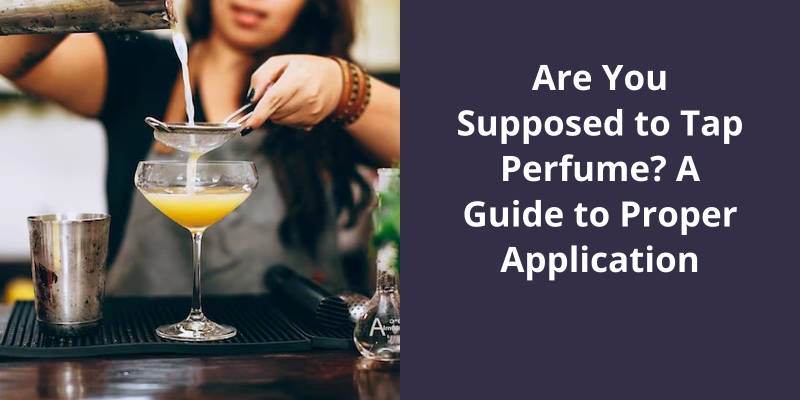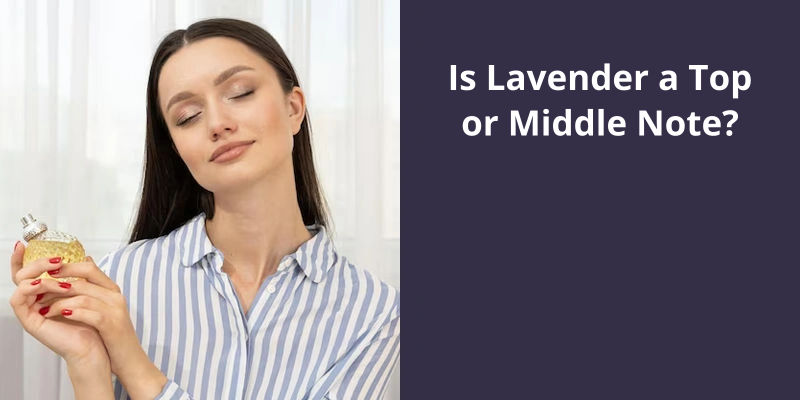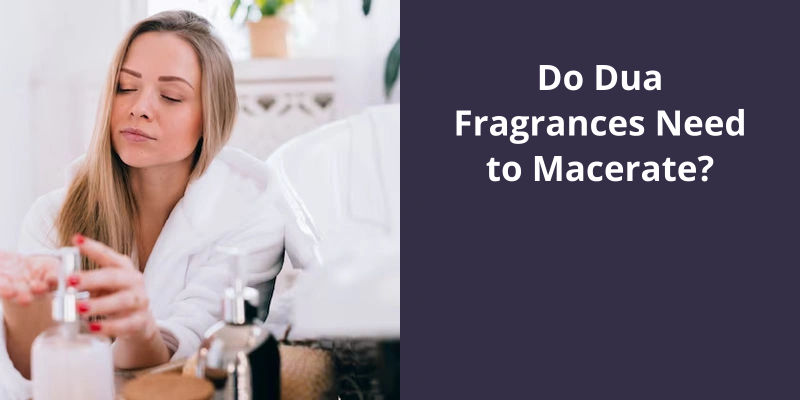You are not supposed to tap perfume. The common belief that you should rub your wrists together after applying perfume is actually a misconception. Rubbing the skin generates heat and it can alter the scent. The correct way to apply perfume is to spray the scent onto pulse points such as your wrists and neck, then let it air dry naturally. This process allows the fragrance to mix with your body’s natural oils, helping it to last longer and smell more like it’s intended. Avoid spraying perfume directly on your clothes as it might stain them. Also, don’t overdo it; a little perfume goes a long way.

Should Perfume Be Rubbed In?
This can alter the way the fragrance develops and ultimately shorten it’s lifespan. Instead of rubbing, opt for gently patting or spraying the perfume directly onto pulse points, such as the wrists and neck. By doing so, the fragrance will have a chance to interact with your bodys chemistry and create a unique scent.
In addition to avoiding rubbing, it’s important to be mindful of the quantity of perfume you apply. Less is often more when it comes to fragrance, as overpowering scents can be unpleasant for those around you. A couple of sprays or dabs should be sufficient to achieve the desired effect.
Furthermore, it’s recommended to apply perfume to clean, moisturized skin, as this helps the fragrance to adhere better and last longer. Avoid spraying directly onto clothing, as perfumes can stain or alter the fabrics scent. If desired, you can lightly mist a fragrance onto a hairbrush and run it through your hair for a subtle and long-lasting effect.
Remember that perfumes are designed to be enjoyed at arms length, not up close. Others should catch whiffs of your fragrance as you move, creating a pleasant aura around you. Therefore, resist the temptation to continuously sniff your wrists or overapply the perfume in order to keep enjoying it’s scent throughout the day.
Ultimately, proper application of perfume involves treating it as a delicate art form. By avoiding rubbing, applying to pulse points, considering the quantity, and taking care of the skin and clothing, you can ensure that your chosen fragrance lasts longer, develops properly, and creates a pleasing olfactory experience for both yourself and others.
Different Methods of Applying Perfume (e.g. Sprays, Rollerballs, Solid Perfume)
When it comes to applying perfume, there are a few different methods you can choose from. One common option is using spray perfumes, which involve pressing down on a nozzle to release a fine mist of fragrance onto your skin. Another option is rollerball perfumes, which have a small rollerball applicator that you glide directly onto your skin. Solid perfumes, on the other hand, come in a solid or wax form that you rub onto your pulse points. Each method has it’s own benefits and can give you a different level of control over the intensity of the scent. Ultimately, the choice of which method to use depends on personal preference and the type of perfume you have.
These pulse points, where the blood vessels are closest to the skin, generate heat and help to project the fragrance naturally. However, it’s also important to consider the type of fragrance and personal preference when deciding where to apply perfume.
Where Is the Best Way to Put Perfume?
When it comes to applying perfume, finding the best spots on your body to spray can greatly impact the longevity and overall effect of your fragrance. While the concentration of the perfume plays a role in it’s staying power, the placement of the scent is equally important. Pulse points have long been considered the ideal areas for perfume application, as they create an environment for the fragrance to flourish and be noticed.
One of the most popular pulse points for spritzing perfume is behind the ear. This sensitive area generates heat, which helps to activate the fragrance, allowing it to slowly release it’s distinct scent throughout the day. Additionally, the base of the throat is another commonly targeted spot due to it’s proximity to the nose. By spritzing perfume here, the fragrance has the opportunity to intertwine with your natural body odor, creating a unique and alluring aroma.
Wrist application is another classic technique that allows the perfume to mingle with your body chemistry and be subtly released as you move your arms. This method is particularly effective for those who gesture with their hands often or talk with expressive arm movements.
Experimenting with different spots on your body and customizing your application based on your personal preferences can be a delightful adventure in finding the perfect balance for your desired scent experience. Ultimately, the best way to put on perfume is wherever makes you feel confident and allows the fragrance to shine, creating a lasting impression that reflects your unique personality.
Alternative Areas to Apply Perfume for a More Unique and Personalized Scent Experience
- Behind the ears
- Inside the wrists
- On the neckline
- On the back of the knees
- In the hair
- Inside the elbows
- On the ankles
- On the inner thighs
- On the cleavage
- On the back of the neck
Instead, it’s recommended to simply let the perfume dry naturally after applying it to your wrists. This will allow the scent to develop properly without any interference from excessive rubbing.
Do You Rub in Roll on Perfume?
When it comes to applying roll-on perfume, it’s a common practice for many people to rub the rollerball onto their wrists. However, this technique might not be the best approach for preserving the fragrance. While it may seem instinctual to rub your wrists together after applying perfume, the rubbing motion can actually have a negative effect on the scent.
Rubbing the perfume onto your skin can cause the top notes to evaporate more quickly, which means that you won’t be able to fully experience the fragrance as it was intended. Instead of rubbing, it’s better to gently dab or pat the perfume onto your skin. This will help to distribute the fragrance without altering it’s composition.
Instead, opt for a gentle dabbing or patting motion to apply the fragrance onto your wrists. By following these proper application techniques, you can ensure that you’re getting the most out of your roll-on perfume experience.
How to Properly Apply Roll-on Perfume on Different Areas of the Body
When it comes to applying roll-on perfume, it’s important to know the right areas of the body to target. One common misconception is that you should tap or rub the perfume into your skin, when in reality, you should avoid doing so.
Instead, simply roll the perfume onto the desired areas of your body. These areas typically include the wrists, neck, and behind the ears. By applying the perfume to these pulse points, you’re allowing the fragrance to mix with your body heat and naturally diffuse throughout the day.
Remember, less is more when it comes to perfume application. Start with a small amount and build up if desired. Over-application can be overwhelming and may lead to a stronger scent than intended.
So next time you reach for your roll-on perfume, remember to roll it onto your pulse points instead of tapping or rubbing, and enjoy the luxurious scent that follows!
Source: How To Apply Rollerball Perfume | Scent Selective
Additionally, spraying perfume directly into your nasal passages can cause irritation and dryness, leading to potential discomfort and even nosebleeds. It’s important to use fragrances responsibly and focus on applying them to the appropriate areas of the body for a pleasant and safe experience.
Is It Bad to Spray Perfume Up Your Nose?
When it comes to applying perfume, it’s important to do so in a way that both enhances the scent and protects your well-being. One common question that arises is whether it’s advisable to spray perfume up your nose. In short, the answer is a resounding no. Perfumes typically contain a high concentration of alcohol, usually around 85-90%. Spraying it directly up your nose can cause discomfort and irritation, as well as potentially harm your delicate nasal passages.
Instead of directly spraying perfume up your nose, it’s recommended to apply it to pulse points and nerve areas. These areas include the wrists, neck, and inner elbows. By doing so, you allow the fragrance to mix with your body heat, enhancing it’s longevity and projection. Additionally, applying perfume to these areas ensures that it’s diffused throughout your personal space, allowing you and those around you to enjoy the scent.
To properly apply perfume, it’s best to spray or dab it onto your chosen pulse points and lightly pat it in to ensure it absorbs into the skin. Give the perfume a moment to settle and interact with your body chemistry before taking a gentle sniff. By allowing the perfume to meld with your natural scent, you can appreciate the fragrance in it’s truest form.
Properly applying perfume is key to ensuring it’s longevity and enhancing it’s fragrance. Follow these 10 tips for the correct application process. Begin by showering or bathing and thoroughly drying your skin. Prior to applying perfume, consider using an unscented body lotion or Vaseline to create a moisturized base. Remember to apply perfume before putting on your clothes. Focus on spraying it on your pulse points and avoid rubbing it in. It’s important not to overdo it, so spritz instead of misting. Lastly, consider combing a small amount into your hair for a subtle and lasting scent.
What Is the Proper Way to Apply Perfume?
Applying perfume can be a delicate art, and getting it wrong can leave you either overpowering or barely noticeable. To ensure that your fragrance lasts longer and creates the desired impact, here are ten tips to follow for proper perfume application.
First and foremost, it’s crucial to start with a clean canvas. Take a refreshing shower or bath and dry your skin thoroughly before applying perfume. Avoid applying fragrance on sweaty or dirty skin as it can alter the scent and reduce it’s longevity.
These substances act as a moisturizing barrier, helping to lock in the scent and prevent it from evaporating too quickly.
When it comes to the order of applying perfume and clothing, many people debate which should come first. The general rule of thumb is to apply perfume before putting on your clothes, as fragrances can sometimes stain or leave marks on fabrics.
To maximize the effect of your perfume, focus on spraying it on your pulse points. These are areas where the blood vessels are closer to the skins surface, allowing the perfume to be more easily activated and spread throughout the body. Common pulse points include the wrists, neck, behind the ears, and the inner elbows.
When applying perfume, it’s important to spray it rather than rubbing it in. Rubbing can create friction and heat, which can alter the composition of the fragrance and potentially dull it’s scent. Instead, give your pulse points a light spritz and let the fragrance settle naturally.
Less is more when it comes to perfume application. Avoid overdoing it by using an excessive amount of fragrance. A little goes a long way, and a few sprays should be sufficient to create a pleasant aroma without overwhelming those around you.
Instead of misting your perfume, try spritzing it. A fine mist may disperse the fragrance too widely, making it less concentrated and reducing it’s longevity. Spraying the fragrance in a more controlled manner allows you to target specific areas and ensure a more even distribution.
Lastly, consider applying perfume to your hair for a longer-lasting scent. The texture of the hair holds onto fragrance molecules, releasing them gradually throughout the day. A gentle combing or light spritz of perfume onto the hair can help create a beautiful and lingering aroma.
Remember to find the right balance and experiment to discover the perfect amount of perfume that suits your personal preference and desired effect.
How to Properly Apply Perfume for Different Occasions (Daytime vs. Nighttime, Formal vs. Casual)
- Choose the right fragrance for the occasion. Consider the notes and intensity of the perfume.
- For daytime events or casual occasions, opt for a lighter fragrance. Citrus or floral scents tend to work well.
- Avoid overpowering scents for daytime. Apply perfume to pulse points, such as wrists and neck, for a subtle effect.
- For nighttime events or formal occasions, go for a more intense fragrance. Woody or oriental scents can create a sophisticated vibe.
- Apply perfume to pulse points for a longer-lasting effect. These points include wrists, neck, behind the ears, and the back of the knees.
- Remember to apply perfume sparingly. Too much can be overwhelming, so a couple of spritzes should suffice.
- Consider the season when choosing a perfume. Lighter, fresher scents work well for warm weather, while heavier scents are more suitable for colder months.
- Always test a perfume before wearing it to ensure compatibility with your body chemistry. Spritz it on your skin and give it time to develop.
- Reapply perfume as needed throughout the day or evening. Fragrances tend to fade over time, so a touch-up can help maintain the desired aroma.
- Lastly, remember that perfume is meant to enhance your personal style. Choose a fragrance that makes you feel confident and matches the occasion.
There are simple tricks to ensure that you can easily touch up your perfume throughout the day without carrying around a bulky bottle. One method involves spraying perfume onto cotton balls or q-tips and sealing them in a plastic bag to preserve the fragrance. By doing this, you’ll have a convenient way to refresh your scent whenever needed.
How Do You Touch Up Perfume?
When it comes to touch-ups, there are various methods to ensure that your perfume stays fresh and vibrant throughout the day. One effective technique is to spray your favorite fragrance on cotton balls and place them in a plastic bag. This allows for easy application on-the-go whenever you need a quick scent boost. By keeping the cotton balls wet and airtight, they’ll retain the fragrance and be ready for use at any time.
Another option for touch-ups is to spritz your perfume directly on q-tips instead of cotton balls. This allows for a more precise application, especially if you only need to target specific areas. Similar to the cotton ball method, place the scented q-tips in a plastic bag and remove all the air to preserve their freshness. This technique is particularly useful when you want a subtle scent touch-up throughout the day.
By utilizing the cotton ball or q-tip method, you’ve the advantage of portability and convenience. With the fragrance encapsulated in a plastic bag, you can easily carry it in your purse or pocket without worrying about any leaks or spills. This allows you to have your favorite perfume readily available for application whenever you desire.
By following this guide to proper perfume application, you can ensure that your fragrance stays fresh and long-lasting throughout the day. So go ahead and give it a try and enjoy the benefits of a well-maintained and subtly captivating scent.
Conclusion
In conclusion, when it comes to the proper application of perfume, the general consensus is that tapping rather than rubbing is the preferred technique. By tapping, you avoid crushing the delicate top notes and allow the layers of fragrance to harmoniously unfold on your skin. While it’s recommended to let the perfume dry on it’s own, if you're short on time or patience, gently tapping any excess on another pulse point like the neck can be a suitable alternative. Ultimately, mastering the art of applying perfume involves finding the right balance between preserving it’s nuances and fully enjoying it’s captivating aroma. So next time you reach for your favorite fragrance, remember to tap, not rub, and savor the enchanting journey it takes you on.





